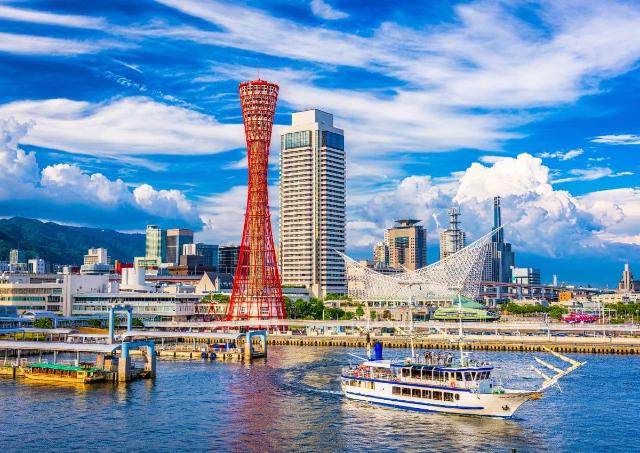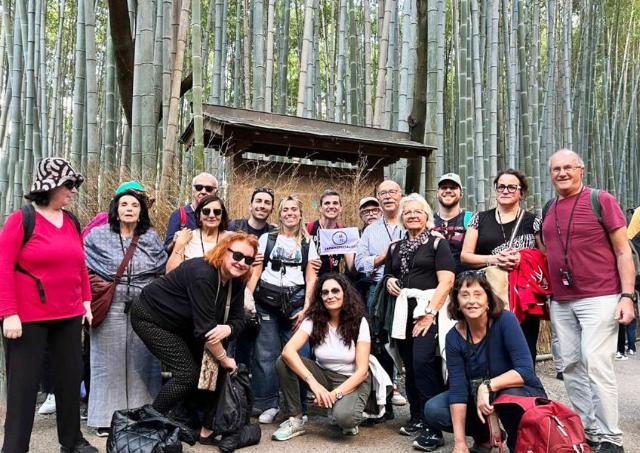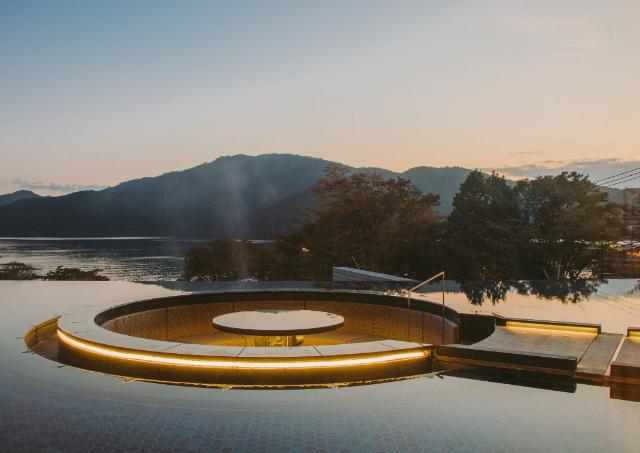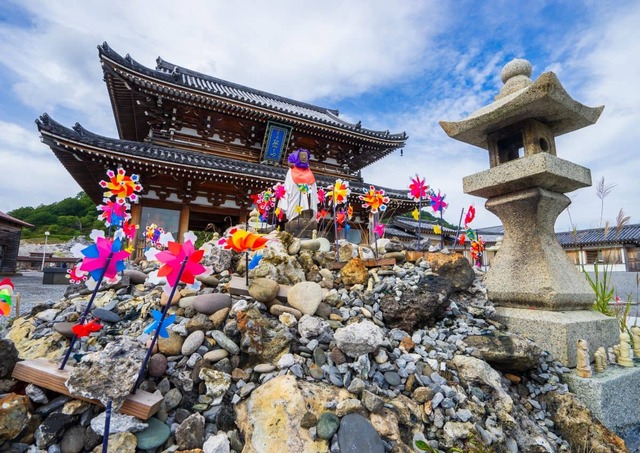Beyond the Beef: Discovering Kobe’s Cultural and Culinary Delicacies
Today, tourists often overlook Kobe in favour of better-known destinations like Osaka and Kyoto, a true shame considering the depth of the city's culture and cuisine. Let's take a deep dive into Kobe to find out why it deserves to be more than just an afterthought in the itineraries of visitors to Japan.
Geography and Climate
Nestled between the waters of Osaka Bay and the rugged peaks of the Rokko mountain range, Kobe boasts a unique geography that sets it apart from other Japanese cities. The city’s landscape is a delightful mix of hills, valleys, and coastal areas, offering a variety of scenic vistas. This geographical diversity is complemented by a mild climate, characterized by four distinct seasons.
In spring, Kobe transforms into a floral paradise with cherry blossoms painting the city in shades of pink. Autumn brings a burst of vibrant colours as the foliage turns red and gold, making it an ideal time for nature walks and hikes. Winters are mild, with temperatures rarely dipping below freezing, allowing visitors to comfortably explore the city’s attractions and enjoy the famous nearby hot springs area of Arima Onsen.
Kobe City Japan - One of the Premiere Sake Producing Areas
Centuries ago, Kobe was not much more than a small fishing village at the foot of Mt. Rokko mountain range. One of the peculiarities of the mountain range is that it produces both exceptionally soft water on one side, making Kobe's tap water one of the best tasting in the world, while also producing mineral-rich water on another side, perfect for growing rice and making delicious sake. The latter type of water flows underground into the springs of the Nadagogo district, where Yamada Nishiki, considered the best rice for sake brewing, is grown. Many of Japan's best-known sake breweries were founded in Nadagogo. With easy access to maritime shipping along the Inland Sea, the sake found its way to many fans around the nation.
Today, many traditional breweries remain in the area, within walking distance of each other, and perfect for a half-day tasting tour on foot and by public transportation. Be sure to visit the Hakutsuru Sake Brewery Museum, which has life-sized dioramas and English-language explanations of the brewing process.
Panoramic Views from Kobe's Beautiful Mt. Rokko and Kobe Nunobiki Herb Gardens
Apart from being the source of Nadagogo’s famous water, Mt. Rokko is one of the key attractions in Kobe City. The spot called Mt. Rokko is the highest peak of the mountain range. It is known for being one of Japan’s “10 million-dollar Night Views”, with the city lights of Kobe and Osaka visible in the distance.
You can take a scenic ride up the mountain by cable car in 10 minutes. But for those who wish to enjoy the area’s natural beauty, there are also four hiking trails up the mountain, which take about 2 to 3.5 hours to hike up (you can always take the cable car back down if you get tired).
At the top of the ropeway, you'll find the gorgeous Kobe Nunobiki Herb Gardens, one of Japan's largest. With a huge variety of over 75,000 types of herbs and flowers, divided among 12 different gardens it is truly a destination for all seasons. The Veranda at Kobe is a cafe featuring an elegantly styled space to rest and tea and food to consume while enjoying the panoramic views. There is also an herbal foot bath, and fragrance and spice museums. The Nunobiki Herb Gardens are open from 10:00am to 5:00pm daily, with the observatory area open until 8:30pm except during the winter season.
Kobe's Cosmopolitan History
In the late 19th century, when the Shogunate government was replaced by the Meiji government who desired stronger ties with the rest of the world, Kobe was opened as an international port, much like Yokohama and Nagasaki. Foreigners wishing to do business in Japan settled in the city, giving it an international vibe that still lives on today. Nankin-machi, Kobe’s Chinatown, still bustles with crowds who come for authentic Chinese cuisine and street vendors selling meat-stuffed buns and other delicacies along the roadside. The vibrant street food scene here is a must-try for any visitor.
The Kitano district, the former foreign settlement area where many foreigners chose to live and work, has preserved more than a dozen former mansions of wealthy merchants and foreign diplomats, which are open to the public as museums. But foreign-inspired architecture isn’t limited to just these areas; Kobe has preserved many art-deco Western style buildings from the early 20th century in the downtown waterfront, some of which have survived the Allied bombings of WW2 and the devastating Great Hanshin Earthquake in 1995.
The Birthplace of Japanese Jazz
It is in this area you will find evidence of another proud connection Kobe has with Western culture: its jazz clubs. The first Japanese Jazz band performed in Kobe in 1923, and over the decades, the city's clubs have hosted jazz legends like Duke Ellington and John Coltrane.
Kobe celebrates its jazz history annually with the Kobe Jazz Street Festival, with many smaller events peppered throughout the year. Jazz bars like Sone, which has been in business since 1969, host evening performances nearly every day of the year. Visitors can make it a night on the town, hopping around jazz bars, restaurants, and enjoying the lively nightlife around Kobe's Sannomiya area.
The Best Restaurants for World Famous Kobe Beef
No conversation about Kobe’s culture and cuisine would be complete without mentioning its most legendary food, Kobe beef. Strict guidelines govern what can be labelled as Kobe beef, which is produced from Tajima cattle raised in Hyogo Prefecture, not specifically within Kobe city limits. It’s intense marbling of fat, rich flavour, and rarity outside of Japan make eating it an experience many visitors have on their bucket lists. Check out this blog post about Kobe beef for restaurant recommendations and more information.
Fortunately, there is no scarcity of restaurants where you can enjoy Kobe beef in the city. Because of the strict guidelines regulating the brand, you can check in advance if the restaurant is serving genuine Kobe beef by checking for its certification with the Kobe Beef Marketing & Distribution Promotion Association.
If you are making a quick stop in Kobe just to try the beef, the Kobe Beef Gallery is conveniently located a few minutes’ walking distance from the Shin-Kobe Shinkansen station. It has a small counter-style restaurant where you can sit and watch the chef prepare a tender cut of steak on the grill, teppanyaki style. But stay longer, and you’ll find you have many choices to experience the flavour and texture of authentic Kobe beef at restaurants around the city.
With its proximity and convenient access from Osaka and Kyoto, it's tempting to make Kobe a simple day trip or a stop for an extravagant meal. But visitors who take the time to explore the culture and cuisine of Kobe will find a fantastic alternative to the sensory overload of Osaka or the stifling primness of Kyoto, a different side of Japan many never get to experience.
Places to Visit in and Around Kobe
Kobe is a treasure trove of attractions, blending historical charm with modern marvels. Here are some must-visit spots:
Kobe Port Tower
Standing tall at 108 meters, the Kobe Port Tower is an iconic symbol of the city. Located on the bustling Kobe waterfront, it offers panoramic views of the harbour and the surrounding cityscape. A visit to the observation deck is a must for anyone wanting to capture the beauty of Kobe from above or watch as the cruise ships come into port.
Kobe Nunobiki Herb Gardens
Accessible via a scenic ropeway ride, the Kobe Nunobiki Herb Gardens are a haven for nature lovers. With over 200 species of herbs and seasonal flowers, the garden is a sensory delight. The views from the top are breathtaking, providing a perfect backdrop for a leisurely stroll.
Kobe Sannomiya Station Area
Situated in the heart of downtown Kobe, this bustling station is surrounded by shops, restaurants, and entertainment options. It’s a hub of activity and a great place to experience the vibrant city life.
Kobe Harborland
This area between Kobe Station and the waterfront is one of Kobe's premiere shopping and entertainment districts. Kobe Harborland consists of the Umie shopping centers with their family-friendly attractions such as a large Ferris wheel and Anpanman Museum, and the Renga Soko, a group of 19th-century brick warehouses along the waterfront that have been renovated in shops and a restaurant.
Sorakuen Garden
Kobe's most famous Japanese garden was once part of the main residence of the Kodera family, an influential Kobe family. The traditional style garden also contains several European style buildings that are preserved as Important Cultural Properties.
Arima Onsen
This hot spring resort area is on the other side of Mt. Rokko from the city, but easily accessible by cable car. One of the area's top attractions, Arima Onsen offers many luxurious ryokan inns and hot springs baths to enjoy overnight.
Ikuta Shrine
Nestled in central Kobe, Ikuta Shrine is one of Japan’s oldest Shinto shrines, known for love blessings and tranquil beauty. A peaceful escape near the city’s bustle, it's perfect for a spiritual pause or cultural stroll under the perfectly lined red torii gates.
Getting to and Around Kobe
Navigating Kobe is a breeze, thanks to its efficient and well-connected public transportation system. Here are some of the main options:
Train: Kobe is well-served by trains, including the Shinkansen (bullet train) at Shin-Kobe Station, various JR trains at Sannomiya Station, and the Hankyu Kobe Line at Kobe-Sannomiya Station. These trains connect Kobe to major cities like Tokyo and Osaka, making it easy to include Kobe in your travel itinerary.
Bus: The city’s extensive bus network covers a wide range of routes, connecting the city centre to surrounding areas. The City Loop Bus is particularly convenient, offering a circular route that stops at major attractions, making sightseeing hassle-free. Inter-city overnight bus service is available from Tokyo for those travelling on a budget.
Subway: Kobe’s subway system is another efficient way to get around. With multiple lines connecting different parts of the city, it’s a quick and convenient option for exploring Kobe.
Taxi: While taxis are readily available throughout Kobe, they can be more expensive than public transportation. However, they offer the convenience of door-to-door service, especially useful if you’re traveling with big luggage or in a group.
Best Time to Visit Kobe
Kobe is a year-round destination, with each season offering its own unique charm. Here’s a breakdown of what to expect:
Spring (March to May)
Spring is a delightful time to visit Kobe, with mild weather and the city adorned in cherry blossoms. The Akashi Park Cherry Blossom Festival is a highlight, offering a chance to enjoy a traditional Japanese tea ceremony amidst the blooming sakura. Kobe Festival, held annually in May, features stage performances, markets, musical bands and food stalls, and a samba dance show connecting to Kobe’s sister city, Rio de Janeiro.
Summer (June to August)
While summer can be hot and humid, it’s a great time to enjoy Kobe’s beaches and outdoor attractions. The Summer Garden Festival, held in Nunobiki Herb Gardens each July to August, welcomes flower- and hiking lovers.
Autumn (September to November)
Autumn is arguably the best time to visit Kobe, with comfortable temperatures and stunning autumn foliage. The Kobe Autumn Festival is an event looking to Kobe's future by promoting the city's unique culture and world-famous brand. On the other hand, the Minato Kobe Marine Fireworks Festival showcases beautiful fireworks at Kobe Harbour’s Meriken Park in October each year. Kobe Jazz Street, held in October each year, is a great occasion to experience Kobe’s jazz scene and listen to jazz performances on Kobe’s streets.
Winter (December to February)
Winter in Kobe is cool and dry, ideal for exploring the city on foot. Kobe Luminarie is an annual winter event commemorating the victims of the Great Hanshin Earthquake with exquisite illuminations made up of thousands of colourful LED lights. Kobe Christmas Market, held in Nunobiki Herb Gardens, gives a romantic setting to the festive season. Nankinmachi Lantern Festival is held in late-December in the Chinatown of Kobe, where over 400 lanterns create a special atmosphere.
By planning your visit around these seasons and events, you can make the most of your time in Kobe and experience the city’s diverse offerings.
Plan your trip with us
Get in touch with one of our travel consultants, they are ready to help you create the trip you always dreamed of.
Online Consultation



